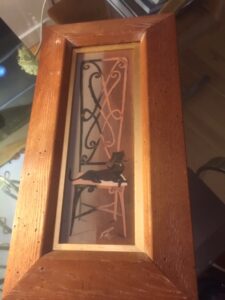 Many people love their dogs, as I do, and own art related to a certain breed. One fine day at an appraisal in Hollywood, I brought my dachshund BEAR. He fits his name, small but powerful, and knows his own mind. My client allowed Bear in her fabulous high rise. Thus began the relationship between my client, who loves dachshunds, and me, who raised three generations of dachshunds. I felt thrilled to find, after I wrote her appraisal, that she sent me a midcentury painting, a gouache on paper, of a dachshund on a ladderback chair. How the dachshund got on a chair as tall as he is wide we will never know.
Many people love their dogs, as I do, and own art related to a certain breed. One fine day at an appraisal in Hollywood, I brought my dachshund BEAR. He fits his name, small but powerful, and knows his own mind. My client allowed Bear in her fabulous high rise. Thus began the relationship between my client, who loves dachshunds, and me, who raised three generations of dachshunds. I felt thrilled to find, after I wrote her appraisal, that she sent me a midcentury painting, a gouache on paper, of a dachshund on a ladderback chair. How the dachshund got on a chair as tall as he is wide we will never know.
So, I wrote this article about the history of breeds in related dog portraiture, a rich area to discuss.
The wonderful little gouache gifted to me comes from the 1960s, but the story goes back further. Let’s travel to the 15th century, when the household dog began to appear in paintings with their owners. The wonderful little Brussels Griffon, as seen in Jan van Eyck’s “The Arnolfini Portrait” (1434) now hangs in the National Gallery London. What an artist does with a DOG in the MIX of a man and his betrothed is to show fidelity, guardianship, and domestic bliss. And this is the earliest representation of the Brussels Griffon.
Many Artists Included Dogs in Art
Another famous dog in art, as a portrait unto itself: Diego Velazquez, “Las Meninas” (1656), hangs at the Museo Nacionel del Prado, Madrid. Velazquez pictures a massive Spanish Mastiff, a protector dog, bred to watch over sheep, family, and children, and a guardian of home. Perfect for the images of the future royal children of Spain. And an early representation of a massive and important breed.
A 1673 painting by Jan Steen shows one of the early images of the King Charles Spaniel, in the work called the “Wrath of Ahasuerus.” It currently hangs at the Barber Institute of the Arts, University of Birmingham, UK. This wonderfully portrays the Spaniel, with its origin in the Iberian Peninsula. Bred to retrieve game birds for the aristocracy, the dog looks nervous, ready to play, as anyone who knows Spaniels will recognize.
Another GREAT image of an early breed, shown in an invaluable work of art, a Poitevin Hound. In Gustav Courbet’s groundbreaking masterpiece, he shows the artist equal to the aristocrat, who here has ownership of the beautiful purebred Poitevin Hound. We see the breed as it is today. The work is called “Bonjour Monsieur Courbet,” (1854) painted by an artist who wanted to paint PURE realism, and deal with the class issue through this method. The dog, as usually, becomes a symbol of what the artist shows, meaning breeding is only as good as what is bred.
Reason for Dogs in Art
Through the world of art, painters celebrated dogs. A definite reason for that exists. The dog became an early symbol of loyalty as well as a symbol of the shortness of life. If you know what I know, as a longtime dog person, they live for almost a cycle in a human’s lifetime, 14-17 years. Then, they’re gone. And, an era in your own life closes.
A dog in art says something about BOTH life and death, with a little bit about loyalty thrown in. My little dachshund painting doesn’t measure up to the level of the works I mentioned. But a painting of a dog breed we love will always make us happy. We remember how our own cycle of life is encapsulated in the many lives of our dogs.
I tried to find the artist of my gift, signed Ritter on that wonderful midcentury painting of a dachshund in a highbacked chair. But that “Ritter” I never found. At this time the image is probably valued in the market because it’s a midcentury theme and style. Thus, value is $400. I thank all those of us who love to see our dogs in art.
Pingback: Artists and Their Dachshunds - Elizabeth Appraisals